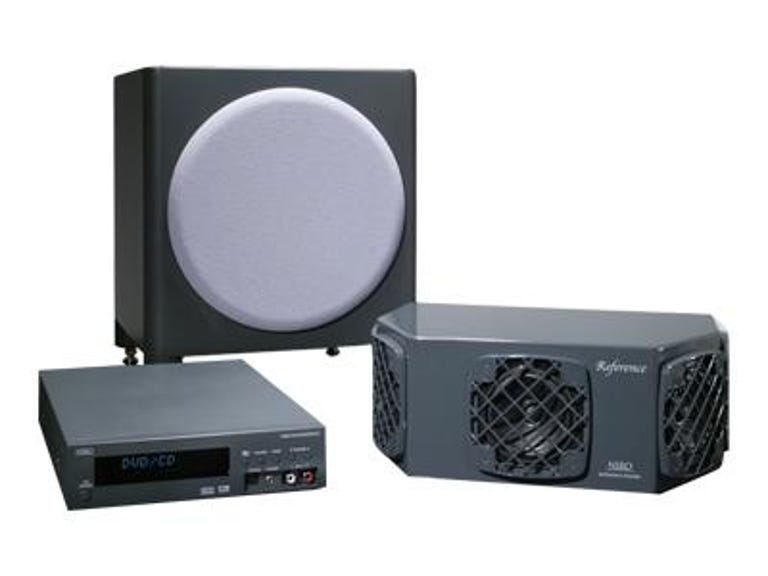Niro's single-speaker home-theater-in-a-box (HTIB) systems are big favorites at CNET because they're a cinch to set up and still deliver heavyweight home-theater thrills. Unlike conventional HTIBs, which rely upon five speakers, Niro's systems use only a main speaker and a subwoofer--along with an amplifier--to fill a room with sound. The company's best single-speaker package, dubbed the Reference ($900 direct), builds on those strengths and shrinks the dimensions of the amp and the speaker. The Reference can also be used with Niro's optional MovieMouse personal speaker. If you'd rather not deal with the setup hassles of running wires and placing five speakers in your home theater, Niro's Reference system is a more than viable option. As on the other Niro HTIBs we've tested, setup chores on the Niro Reference have been reduced to the absolute minimum. Hook up the Reference's main speaker, the subwoofer's connectors, and a digital cable from your DVD player and cable/satellite box, and you're done. Better yet, you won't have to navigate setup menus or calibrate sound levels. We had the Reference up and running in less than five minutes.
The brawny main speaker is beautifully finished in gray lacquer paint, and industrial-looking wire grilles protect its drivers from inquisitive fingers--although the look may be a bit too industrial for some tastes. The speaker measures a trim 12.5 inches wide, 4.5 inches high, and 7.9 inches deep. The preferred speaker placement is immediately above or below the TV, angled up or down toward the listeners' ears. Niro offers a bracket ($10) for mounting the 7.5-pound speaker on a wall (requires the OmniMount 20.0 mount) and an adapter ($20) for mounting it directly on a TV or a monitor. The 1-foot-cube subwoofer weighs 14 pounds.
The Good
The Bad
The Bottom Line
Even by HTIB standards, the dark-gray amplifier is petite--a mere 7.9 inches wide, 2.2 inches high, and 11.7 inches deep--so you can stash it in the most cramped entertainment centers or cabinets. The little fella's front panel has six tiny buttons to handle volume control, input selection, and surround mode. Its cooling fan is truly whisper quiet. The remote control offers direct access to the bass and treble levels as well as the subwoofer, center, and rear-channel volumes.
Connectivity options are few: you get only three optical digital inputs and two stereo inputs between the front and rear jacksets. The Reference routes only audio signals, so you'll have to connect video gear such as your cable box and DVD player directly to your display and switch the two separately. Unlike most HTIBs, the system does not include a DVD player.
The Reference is also fitted with an output jack for use with Niro's "personal-theater" speaker, the MovieMouse, which has a unique design that's ideal for late-night movie-viewing sessions (see our review of the MovieMouse for more).
Conventional surround sound is achieved with five or more satellite speakers carefully positioned around the home theater. Niro's proprietary technologies have reduced the number of speakers to just one, so the question is: just how convincing can that sound be? Thanks to Niro's latest processing tweaks, the Reference produced the most convincing illusion of surround we've ever heard from a single-speaker HTIB.On the concert DVD The Last Waltz, which celebrates The Band's final show, the Reference projected applause well ahead of the front "stage." We heard a true 180-degree arc of wraparound sound, but no, we never heard sound coming from behind. That said, once we were engrossed in the movie, we never missed the more complete surround effect we get from bona fide 5.1 systems.
The Man On Fire DVD's action sequences had impact aplenty, and the single speaker and the sub never betrayed their demure dimensions. Dialogue was clear and still had the weighty authority characteristic of a larger center speaker.
While we didn't have Niro's older 1.1Pro on hand for direct comparison, we think the Reference might be more adept at playing CDs. Rocking out with the Led Zeppelin II CD was a lot of fun, and we recall the Pro stumbling on hard rock. Jeff Buckley's Grace CD was even better, and tracks such as "Lilac Wine" and "Hallelujah" were breathtakingly beautiful. Still, we caution readers that the Reference will be best appreciated in small to midsize home theaters; its power shortfall will become more obvious as you crank the volume.



